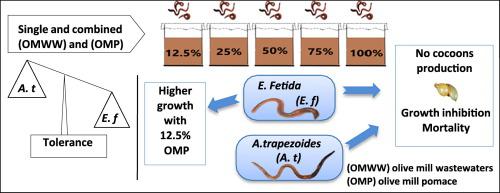Applied Soil Ecology ( IF 4.8 ) Pub Date : 2021-06-21 , DOI: 10.1016/j.apsoil.2021.104123 Nawal Mekersi , Kenza Kadi , Silvia Casini , Dalila Addad , Kamel Eddine Bazri , Salah Eddine Marref , Sabrina Lekmine , Asma Amari

|
The extraction processes of olive oil produce huge amounts of by-products, such as olive mill wastewater (OMWW) and olive mill pomace (OMP), these by-products have significant polluting properties related to their undesirable color and odor, high organic load, acidic pH, high phenolic compounds, high salinity, while their effect on soil organisms is unclear. The study into the effects of these by-products on soil bioindicators, such as earthworms should therefore be prioritized. Indeed, the purpose of this study was to evaluate the effect of environmentally realistic concentrations of olive mill wastewater and olive mill pomace on the growth, reproduction, and survival of the earthworms Aporrectodea trapezoides, and Eisenia fetida. Bioindicators were exposed under laboratory conditions to increasing doses (12.5%, 25%, 50%, 75%, and 100% w/w) of OMWW and OMP separately and in combination. The results showed a higher growth rate on Eisenia fetida when exposed to 12.5% OMP, with a neutral effect on reproduction and survival. Toxicological effects were found at higher doses, namely: there was no cocoon production, growth inhibition, and mortality; these effects were probably due to the higher level of phenolic compounds and higher salinity. In general OMP was found to have toxicity higher than OMWW, the combination of both by-products showed stronger effects on some earthworm endpoints. Comparative responses between the two species showed that Aporrectodea trapezoides proved to be more tolerant. Dilution and bioremediation of these by-products is recommended as a possible solution to reduce their toxicity.
中文翻译:

单独和混合橄榄磨废水和橄榄磨渣对两种蚯蚓的生长、繁殖和存活的影响(梯形Aporrectodea , Eisenia fetida)
橄榄油的提取过程会产生大量副产品,例如橄榄磨废水 (OMWW) 和橄榄磨渣 (OMP),这些副产品具有显着的污染特性,与它们令人不快的颜色和气味、高有机负荷、酸性 pH 值、高酚类化合物、高盐度,而它们对土壤生物的影响尚不清楚。因此,应优先研究这些副产品对土壤生物指标(如蚯蚓)的影响。事实上,本研究的目的是评估橄榄磨废水和橄榄磨渣的环境现实浓度对蚯蚓Aporrectodea trapezoides和Eisenia fetida的生长、繁殖和存活的影响. 生物指示剂在实验室条件下分别和组合暴露于递增剂量(12.5%、25%、50%、75% 和 100% w/w)的 OMWW 和 OMP。结果表明,当暴露于 12.5% 的 OMP 时,Eisenia fetida 的增长率更高,对繁殖和存活的影响为中性。在较高剂量下发现毒理学效应,即:无茧产生、生长抑制和死亡率;这些影响可能是由于酚类化合物的含量较高和盐度较高。总的来说,发现 OMP 的毒性高于 OMWW,两种副产物的组合对某些蚯蚓终点显示出更强的影响。两个物种之间的比较反应表明Aporrectodea 梯形事实证明更宽容。建议对这些副产品进行稀释和生物修复,作为降低其毒性的可能解决方案。











































 京公网安备 11010802027423号
京公网安备 11010802027423号